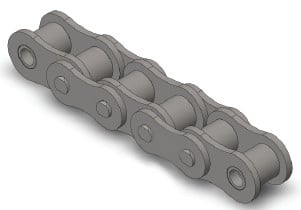Roller chains are one on the most productive and expense eff ective ways to transmit mechanical power among shafts. They operate in excess of a wide selection of speeds, handle huge functioning loads, have pretty tiny energy losses and are commonly cheap compared with other techniques
of transmitting electrical power. Effective choice includes following numerous rather simple steps involving algebraic calculation and the use of horsepower and services issue tables.
For almost any offered set of drive ailments, there are a variety of possible chain/sprocket confi gurations that can successfully operate. The designer therefore must be mindful of many simple selection principles that when applied the right way, help balance general drive effectiveness and cost. By following the techniques outlined on this section designers needs to be capable to make choices that meet the requirements on the drive and therefore are price eff ective.
Standard Roller Chain Drive Principles
? The recommended quantity of teeth for the modest sprocket is 15. The minimum is 9 teeth – smoother operation is obtained with a lot more teeth.
? The advisable optimum variety of teeth for the big sprocket is 120. Note that although a lot more teeth makes it possible for for smoother operation having too a lot of teeth prospects to chain jumping off the sprocket following a comparatively smaller volume of chain elongation resulting from wear – That’s chains having a extremely big amount of teeth accommodate less wear just before the chain will no longer wrap around them properly.
? Speed ratios needs to be 7:1 or less (optimum) and never greater
than ten:one. For bigger ratios the use of several chain reductions is suggested.
? The recommended minimum wrap on the little sprocket is 120°.
? The suggested center distance between shafts is 30-50 pitches of chain. There are two exceptions to this as follows:
one. The center distance need to be better than the sum of your outside diameters of your driver and driven  sprockets to prevent interference.
sprockets to prevent interference.
two. For speed ratios greater than 3:1 the center distance should not be significantly less compared to the outdoors diameter of your substantial sprocket minus the outdoors diameter from the tiny sprocket to assure a minimal 120° wrap all over the compact sprocket.